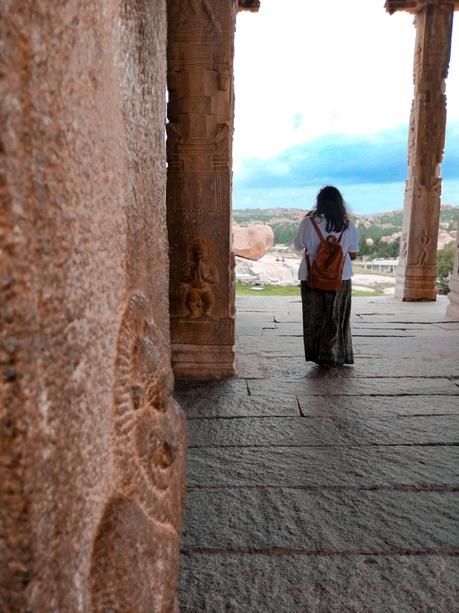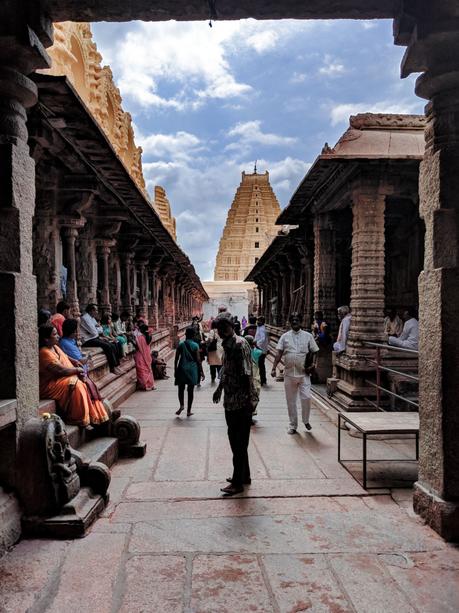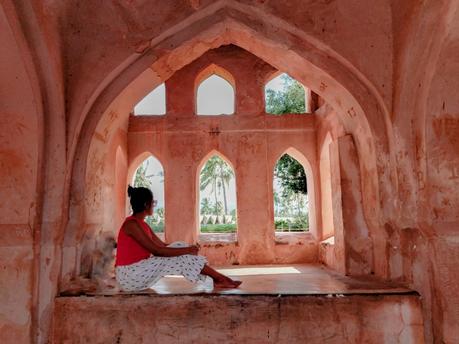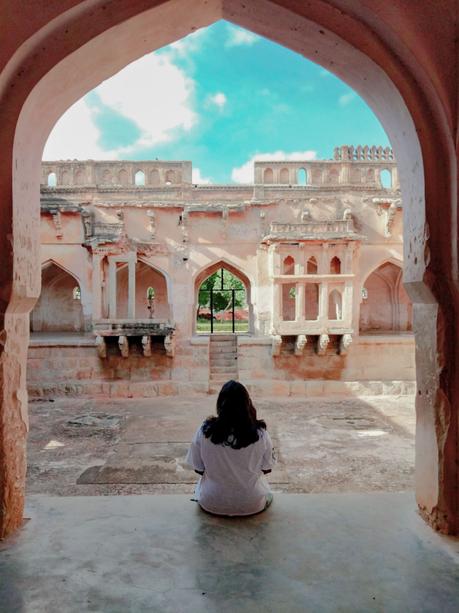The city of Bidjanagar is such that the pupil of the eye has never seen such a place like it, and the ear of intelligence has never been informed that there existed anything to equal it in the world.
- Abdur Razzak, Ambassador from Persia
Vijayanagara - City of Victory. An empire long erased; all that is left is stone and ruin.
It is these stones, the ones man chipped away, the ones carved into magnificent structures and intricate sculptures, the ones rendered smooth by the elements, that are ripe with tales.
These tales are not ordinary. They are spellbinding, speaking of a time before the Rayas. They whisper the legend of princess Pampadevi, the human avatar of Goddess Parvati, and her devotion that captured Shiva's attention, who offered to wed her as boon. Thus, Shiva earned the name Pampapathi - consort of Pampa - and the land was christened Pampakshetra.

As the sands of Time trickled, the town fell into oblivion; until 1336. Legend speaks of the hound of the brothers Hakka and Bukka being chased by a hare it had been hunting, at the very spot that is Hampi. The brothers soon laid the foundation of their empire here.
Today, Hampi is famous as the capital of the erstwhile Hindu Kingdom of Vijayanagara. With earthy boulders, Dravidian-style monuments, expansive paddy fields, and the glittering Tungabhadra River, it is a conflux of dynasties, an open museum and a budget traveller's paradise.
Marvel at ancient monolithic structures
Atop the Hemakuta Hill stand many ancient edifices; my eyes seek the grandest of the lot - a monolithic Bengal-gram bellied idol of the elephant-god.
We place our palms on a toe of the Kadlekalu Ganesha; we are astounded by the scale. As we trace the mythical themes carved on slender granite pillars with our fingers, we cannot help but be transported to the era of the Rayas and beg them to divulge the workings of their artistic faculties.
A beatific legend states that a peasant woman commissioned the largest in Hampi, and the name Badava (poor) linga was bestowed upon it.
Absorb the natural beauty of Hampi
- Domingo Paes, Portuguese visitor to the Vijayanagara Empire.I climbed a hill whence I could see a great part of it; I could not see it all because it lies between several ranges of hills. What I saw from thence seemed to me as large as Rome, and very beautiful to the sight. There are many groves of trees within it, many orchards and gardens of fruit trees and many conduits of water which flow in the midst of it, and in places there are lakes...
Behold the birthplace of Hanuman
On the other side of the river lies Anegundi, the original capital of the Vijayanagara empire. Legend dictates that this is Kishkinda, the mythical monkey kingdom from Ramayana, and Anjanadri Hill is the birthplace of Hanuman.
We ascend six-hundred steps under the unforgiving sun - a small price to pay for the entrancing atmosphere atop the hill. A whitewashed shrine to Hanuman looks upon the green landscape as if in benevolence. The temple is sanctuary to a lone rock floating in water - a piece from the famed mythical bridge to Lanka.
Appreciate the intricate carvings of the Krishna Temple
King Krishnadevaraya was a lover - of art and architecture, of Lord Vishnu and his incarnations. When he conquered Utkala in 1513, he commissioned a temple to the infant Lord Krishna, immensely ornate and vividly colourful.
Today, Utkala is known as Orissa, and the temple is but a ghost of its past glory. Yet, remains of the gopura, exquisitely carved , inscribed epics, and an account of the conquest welcome us while praising gods and kings with hushed songs.
Walk up the slopes of the legendary Hemakuta Hill
When Shiva consented to marry Pampa, the gods reciprocated by showering gold upon a hill. Hemakuta - the golden hill - slopes imposingly, beckoning travellers to rest upon its smoothed surface.
Of all the Shiva temples on the hill, only one stands miraculously unscathed, albeit at the foot of Hemakuta - the Virupaksha Temple.
Experience childlike glee in a coracle
Sanapur and Kamalapur lakes are lined with coracles, their oarsmen always ready for visitors. We strike a conversation with them, listening to their stories of the land, their lives, and their dreams, as we twirl gently on glassy waters.
Be humbled by the vast Royal Enclosure
The victory of the Bahmani Sultanates at the battle of Talikota in 1565 commenced the end of the Vijayanagara empire. For six months the victors desecrated temples, pillaged royal coffers, and reduced sandalwood palaces to ashes. The last of the Rayas were no match for their predecessors' statesmanship. The capital fell desolate; the empire a mere chapter in history's pages.
We paint with imagination the discourses in the Durbar Hall, the glimmering brocades of silk swathed by courtiers at the Mahanavami Dibba during Dussehra, the hushed covert meetings in the Underground Chambers, the aqueducts that supplied fresh water to the entire town, and an empire at its zenith.
Spend quiet moments by the river
The Tungabhadra river bears the same ancient identity as the princess from whom the land gets its name. In earnest it flows through the temple town, quenching person, animal, and crop as it did centuries ago.
Chant praises to the gods at Virupaksha Temple
At the site of the nuptials of Shiva and Pampa stood a humble stone shrine. Here, devotees bowed vermilion-streaked foreheads to the divine pair centuries before the arrival of the Rayas, and continue to do so long after their passing.
The shrine is no longer simple. A many-tiered and sumptuously sculptured gopura welcomes those who flock to offer prayers, observe fresco ceilings, and marvel at an inverted pin-hole image of the gateway.
The scent of incense envelops us as we step into the low-roofed inner shrine, the holiest place in the temple. Inside is a sculpture of a serenely smiling couple, smeared with reds and yellows, adorned in green silk. We bow our heads to Pampadevi and her consort Virupaksha as the priest pours coconut water into our cupped palms.

Lose yourself in the intricacies of the Vittala Complex
The Rayas were an extravagant lot. They prayed, dined, danced, and did so impressively. For these purposes they constructed an ornate structure - the Vittala Complex.
In the Vijaya Vittala Temple they sang praises to Lord Vishnu, while outside, his vehicle Garuda lay in wait in his stone-chariot shrine. Ladies of the court danced as musicians expertly drummed their fingers on the Musical Pillars to produce scintillating tunes. Painstakingly chiselled Yalis welcomed ambassadors and common-folk with their chimeric appearance. The royals were proud of their creations, an evidence of their extravagance for posterity.
Climb up the Matanga Hill for spectacular views
An ancient trail, still intact, leads us to the top of the Matanga Hill, the highest point in Hampi. A small shrine to the cult deity Veerabhadra stands unmoving against a backdrop of river, boulders, and plains.
We climb up the rooftop. Glasses of hot chai go around to keep the evening chill at bay, as the golden sun dips and lends a furious wash of colour to the cosmic canvas. We bid adieu to another day.
Revel in a miscellany of cuisines
The hospitality of their ancestors continues with Hampi's locals, who make visitors from across the globe feel at home with a multitude of cuisines - Indian, Continental, Oriental, Israeli, and Lebanese.
Be enchanted by the ornate Queen's Bath
When eyes fall on the opulent bathing complex that is the Queen's Bath, time comes to a standstill, and one gets a peek into the luxuriant lives of the Vijayanagara royals.
The scent of flower garlands and perfumed water are long gone, and so are the royals for whom this complex was constructed. The sheen of the lime-plastered walls has faded, and many facets of the complex are no more. Yet, bubbling streams can be heard in the quietest of recesses, echoing lavish tales of consorts past.
Say a prayer, make a wish
In Anegundi stands a nondescript temple to goddess Durga, where the rulers of Vijayanagara prayed for strength and victory before going into battle.
Devotees continue to trickle in via the gateway of the Anegundi Fort. They tie colourful bundles to the tree, symbolic of their wishes.
Witness surreal sunrises and sunsets
Each evening greets us with a differently hued sunset. One day, we drink in a burst of orange as the clouds gaily part in the sky.
Another day, we are shown a reserved view - of a river threading through excrescence of granite, of a devout temple town, of swaying banana plantations, all paled by a palette upon which the gods have stroked the tips of their painted brushes.
Let the mighty Elephant Stable impress you
In the royal stable stood elephants mounted with glittering howdas, trumpeting sonorously as they shifted their weight on their legs, eager for bales of sugarcane.
As we walk towards this 15th century Indo-Islamic structure, we imagine these privileged specimen, carefully bred and selected to carry upon their backs trusted mahouts and members of the royal family.
Admire the confluence of styles at the Lotus Mahal
Within the Zenana walls lay the Queens' chambers, the Treasury, and the royal harem. The king's wives, daughters, and courtesans would lounge under the shade of fruit trees. They would discuss their allowances and investments. They would trade secrets and gossip. And per the carved platforms of the Royal Enclosure, they would prepare for hunts.
Upon the Lotus Mahal we rest our eyes. We gaze upon its elegantly carved walls. We see inlet spouts for water, which cooled the building during hot summer months. We hear the tinkling laughter of the zenana ladies as they hurry up the stairs. The lingering scent of their trail and the chiming music of their anklets leave us inexplicably joyful.
Shop to your heart's content in the village
We pick up keepsakes from the streets adjoining the Virupaksha Temple, and the flea markets on Hampi Island - memories of our quest for ancient legends and contemporary stories, a piece of magical Hampi for our homes.
Itinerary
Duration of the trip - 3 days, 2 nights.
Cost for two - INR 13,000 excluding personal shopping.
Location - Near Hospet in Karnataka, India.
Getting there - Via flight, bus, train, or car/bike.
What to expect
The land - On one side of the river lies the orthodox Hampi Village, where consumption of alcohol is prohibited. Hampi Island (Virapapur Gadde, Anegundi) is more laid back; recreational cannabis is available here.
The people - The locals are friendly, hospitable, and always ready to help out.
The language - Although the native language is Kannada, most locals are multilingual, speaking fluent English, Hindi, some Telugu and Tamil.
The food - Eateries in Hampi Village serve only vegetarian food (with the exception of egg). in Kamalapur offers non-vegetarian dishes.

The climate - Hampi is generally dry and hot, with summer running from March to early June. Monsoon lasts from late June to early August. November to February are cooler months.
The surroundings - Hampi's charm lies in its pastoral quality - expect temple bells, dirt roads, cattle strolling, and monkeys on rooftops.
Safety - Hampi is perfectly safe for all kinds of travellers. 🙂
Tips -
- Carry sufficient cash; the nearest ATM is in Kamalapur. Many places accept Paytm transfers.
- Carry and an to stay protected from the sun and sudden rain spells.
- Carry bottles of water, and snacks to tide the climbs.
- Hampi is an active religious site. Don appropriate and comfortable clothing when visiting the Virupaksha Temple and the temples in Anegundi. Not only will you be shielded from the scorching heat, but you will also show the locals that you respect their culture and traditions.
- Haggle, if that's your style. I didn't mind paying the raised rates since tourism is the main source of income here. Nevertheless, if you feel like you're getting a terrible deal, bargain fairly.
- Read about Hampi and its history. You won't regret it.
- Hire a guide. The larger sites and temples possess many hidden gems that the internet does not reveal.
- Hampi is a UNESCO World Heritage Site, and the monuments are centuries old. It is our duty to protect the town from litter and vandalism.
Planning resources
is a comprehensive resource that offers everything from the best routes and itinerary maps, to the history of Hampi.
My recommendations
When to visit - Although November-February is touted as the best time to visit Hampi, try mid-August to early September - the weather is agreeable due to the waning monsoon, tourists are sparse, and prices are cheaper.
How to travel - Travel by if on a tight budget. Travel within Hampi can be undertaken on foot, rental bikes, auto-rickshaws or buses, depending on the season, distance and terrain.
Where to stay - Archana Guest House in Hampi Village, and Mowgli Guest House in Virapapur Gadde. Hampi Village and Virapapur Gadde are havens for budget travellers. Hotels in Kamalapur and Hospet offer better creature comforts.
♥ Use my Booking.com code to get INR 700/- off your first booking! ♥
Where to eat - Anyone who's been to Hampi will swear by for its hippie ambiance.
Who should guide you - Manju - +91 81236 58150. His meticulous description of the monuments will leave you mesmerized.
As I end this post, I am reminded of a Biblical verse from the Book of Genesis -
For you are dust, and to dust you shall return.
Hampi was birthed from legends, a capital with a long, prosperous existence under the sovereignty of the some of the most minds of the era - now a rubble of ruins.
These ruins are proof of a grand epoch. They leave us conversing with kings and commoners of bygone centuries, and deciphering the thoughts that shaped this last capital of the last great Hindu Kingdom of Vijayanagara.
In dust, their legacy lives on.



